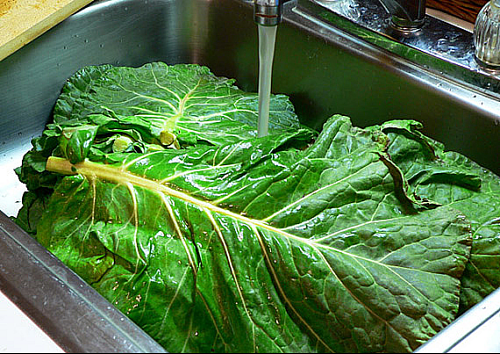Collard greens! We can’t live without ’em! They play a huge role in our community especially during the holidays and at gatherings. When it comes to nutrition, they’re chock-full of ‘good stuff’ like vitamins A, B-6, C and K, and minerals like calcium, iron, and magnesium. The super-low-in-calories, cruciferous vegetable family member is also rich in phytochemicals (plant chemicals) which are believed to protect cells from damage that could progress to cancer. Collards are said to offer protection against such chronic illnesses as diabetes, heart disease and Alzheimer’s. A healthy complexion, increased energy, lower weight and overall mortality can also be attributed to these yummy greens.
Collards also contain a water-soluble, vitamin-like, essential nutrient called choline that is mostly found in many plants and animal organs. Scientists, who have researched choline discovered that it helps with muscle movement, learning, memory, and sleep. Choline contains folate that can aid in depression. Another health benefit to shout out about collards is their ability to actually lower cholesterol more than any other member of the cruciferous tribe, which beats out kale, mustard greens, broccoli, and even Brussel sprouts. Collards can also aid the digestive tract by binding bile acids which makes it easier for them to exit the body.
Now, we typically cook our collards by adding some spices and throwing in either pork, beef, or smoked turkey. According to food scientists, just adding 1½ cups of collards to your diet at least three times a week gives your body a real healthy injection of ‘good stuff!’ Some southerners even drink a collards concoction they refer to as potlikker which is just the veggie, slow-cooked down in a broth. Slaves used to cook collards, drain them, then feed the potlikker to their families.
Now that we’ve got your mouth watering just thinking about collards, run out and get a bunch or two. Choose collards with leaves that are firm and smooth. Fresh leaves can be stored for up to three days in the fridge and up to ten days in the freezer. If you’ve had them cooked, try eating them raw in a salad.
Since juicing is all the rage, toss a couple of collard leaves into your juicer along with a carrot, 2 small green apples (cored), ¼ lemon (without the peel and seeds), 1-inch ginger, and viola, you’ll not only have a healthy but yummy drink as well.
But wait!
Since the holidays are here, we have to share our fave collard greens recipe with you. Judyth Watson-Remy, our features editor, is known around these parts for her collards. She didn’t mind sharing her famous recipe for the yummylicious green veggie with you, our 50BOLD.com fam.
Judy’s Have Mercy Collards
- 2 cups finely chopped red onion
- 4 slices bacon, chopped
- 1½ cups chicken stock
- ¼ cup apple cider vinegar (you can also use white vinegar)
- 1 teaspoon brown sugar
- 2 pinches of red pepper flakes (or more to taste)
- 3 teaspoons of smoked paprika
- 4 pounds collard greens – thoroughly washed, trimmed (be sure to cut off the stems), and chopped
- salt and ground black pepper to taste
Directions
-
Cook bacon and then add onion in a large pot over medium-high heat until it is soft, 5 to 7 minutes. Add chicken stock, vinegar, brown sugar, smoked paprika, and pepper flakes; cook and stir until brown sugar has completely dissolved, about 2 to 3 minutes.
-
Add 1/2 of the collard greens, reduce heat to medium, and cook until greens are slightly wilted. Add remaining greens, toss to combine, and simmer over medium-low heat until silky and tender, about 45 minutes to an hour (cook the collards until they are tender to your liking). Season with salt and pepper.











